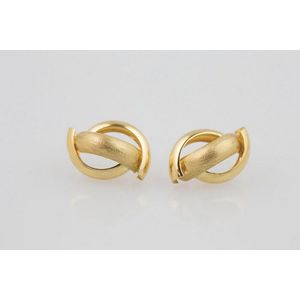Opal and Gold Dress Rings Collection
Three opal set dress rings and one gold dress ring, comprising a 14ct yellow gold two stone solid opal set dress ring of abstract, style, one set with a lovely boulder opal of striated colour bezel set, flanked by a smaller black cabochon opal, the second 14ct yellow gold, set, with a semi black oval cabochon opal and smaller square cut to side, the third 9ct topped on silver band, featuring a kite shaped white opal backed by black backing to show colour, finally a 9ct yellow gold dress ring set with oval blue paste stone in claw setting.
You must be a subscriber, and be logged in to view price and dealer details.
Subscribe Now to view actual auction price for this item
When you subscribe, you have the option of setting the currency in which to display prices to $Au, $US, $NZ or Stg.
This item has been sold, and the description, image and price are for reference purposes only.
- Bezel - On a clock or watch, the bezel is the metal frame into which the watch or clock glass is fitted. In clocks, the bezel may include a hinge and a flange, in effect a door to the face of the clock. In jewellery the bezel is a band of metal with a projecting lip that holds the gemstone in its setting.
- Cabochon Cut in Jewellery - A cabochon cut is a type of gemstone cutting where the stone is cut and polished in a convex shape with a flat bottom and a domed top, with no facets. This type of cut is typically used for opaque or translucent stones that have natural patterns or inclusions that are best displayed in this type of cut. Examples of stones that are often cut as cabochons include turquoise, opal, and moonstone.
- Paste / Rhinestone / Diamante - Paste (or rhinestone or diamante) is the name given to a coloured glass composition used for imitation gemstones, or to imitation gemstones made of glass.
Although the technique of glassmaking had been known for thousands of years, but it wasn't until a lead glass with similar optical properties to diamonds were invented by a German jeweller working in Paris (either "Stras" or 'Strasser") in the early 18th century that "paste" gemstones became popular.
There was no social stigma attached to wearing imitation stones, and they were worn in situations where highway robbery was a possibility. The 18th century settings were of very high quality, equivilent to real gemstone jewellery.
In the nineteeth century the quality of paste jewellery declined and it has remained the poor cousin to genuine gemstones ever since.
This item has been included into following indexes:
Visually similar items

A pair of jadeite and 9ct gold stud earrings. (gilt metal scrolls)
Sold by
in
for
You can display prices in $Au, $US, $NZ or Stg.

Pair 18ct triple twist stud earrings pierced
Sold by
in
for
You can display prices in $Au, $US, $NZ or Stg.

9ct yellow gold, opal and diamond ring, (opal triplet - top layer is damaged but opal appears to be OK), total weight approx 5.15 grams,size: N-O/6-7
Sold by
in
for
You can display prices in $Au, $US, $NZ or Stg.

9ct yellow gold and green stone ring weight: approx 3.8 grams, size: L-M/6
Sold by
in
for
You can display prices in $Au, $US, $NZ or Stg.
